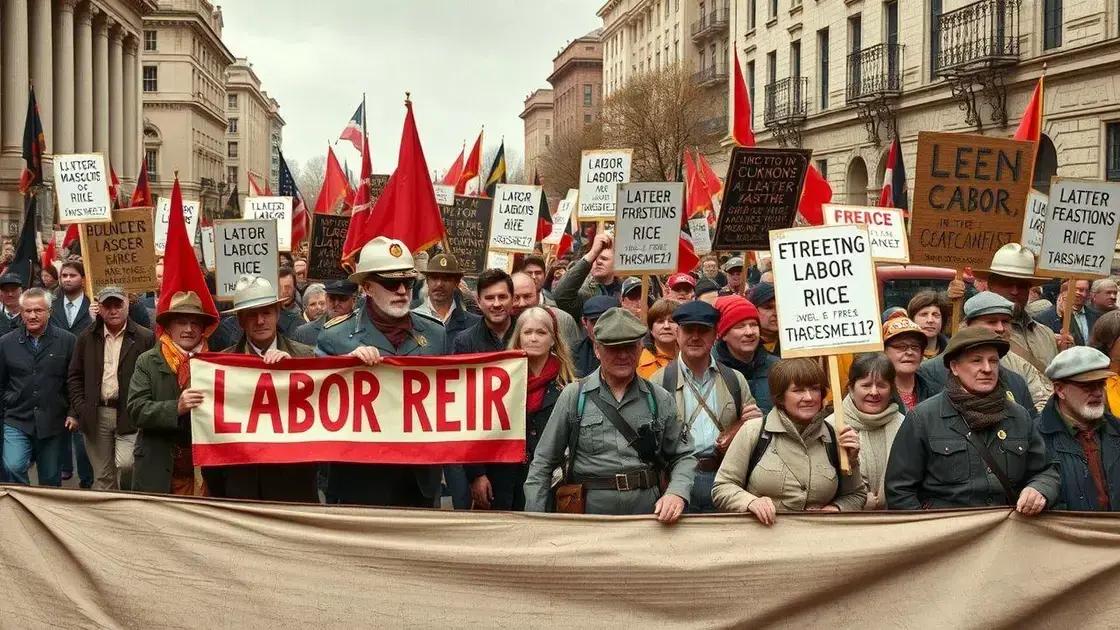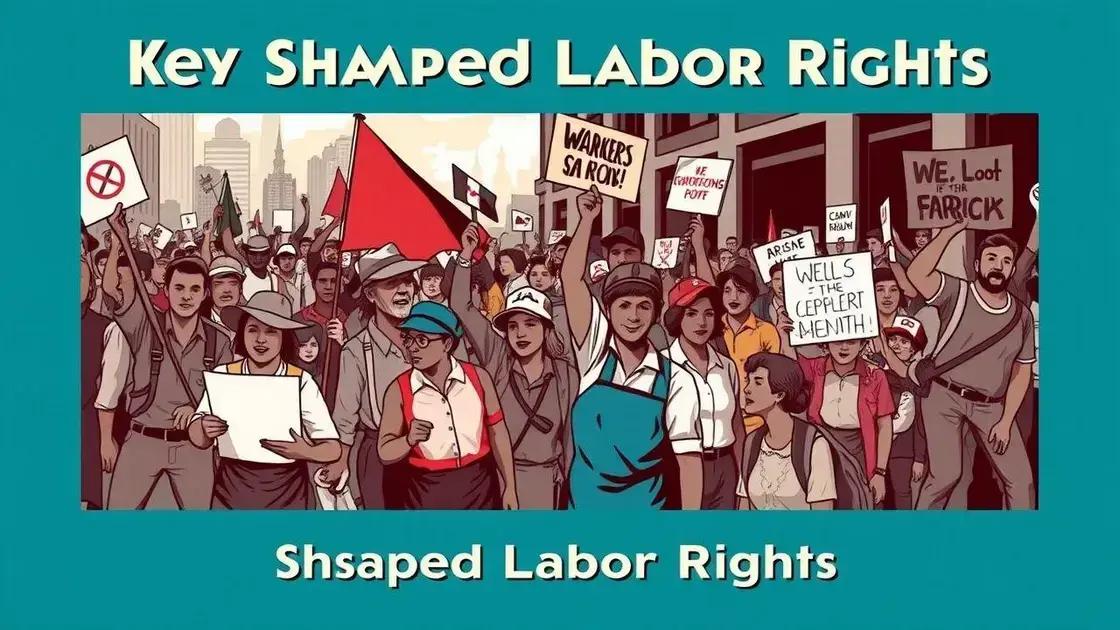Particular labor movement stories that inspire change

Particular labor movement stories highlight the struggles and triumphs of workers fighting for their rights, showcasing resilience and the ongoing fight for fair treatment in the workplace.
Particular labor movement stories provide a lens into the struggles and victories of workers who fought for their rights. Their experiences not only enlighten us but also encourage ongoing activism. Have you ever wondered how these stories shape our current labor landscape?
the origins of labor movements
The origins of labor movements can be traced back to the early industrial era when workers began to unite for better working conditions. As factories emerged, laborers faced long hours, low pay, and unsafe environments. These harsh realities motivated individuals to band together to demand change.
In many regions, early labor unions formed to protect the rights of workers. These groups were pivotal in raising awareness about the struggles faced by laborers. They sparked movements that would lead to significant reforms.
Key Events That Sparked Change
Several notable events played crucial roles in the development of labor movements:
- The Industrial Revolution: This period marked the transition to new manufacturing processes, dramatically transforming labor.
- The Formation of Unions: Unions like the American Federation of Labor fought for fair wages and better conditions.
- The Pullman Strike: This nationwide railroad strike highlighted the need for improved labor laws.
These milestones illustrate how collective action began to reshape the landscape of labor rights. As movements gained momentum, they worked to achieve goals such as fair wages, reasonable hours, and safe working environments.
By the late 19th century, labor movements had started to influence public policy. Legislators began to take notice of the demands from organized labor, leading to groundbreaking legislation that addressed workers’ rights.
impactful figures in labor history
Throughout history, many individuals have become impactful figures in labor history, fighting for the rights of workers. Their efforts have paved the way for significant advancements in labor laws and conditions. These leaders exhibited dedication and courage, often risking their own safety for the betterment of others.
One of the most notable figures is Samuel Gompers. He founded the American Federation of Labor (AFL) in 1886 and played a crucial role in advocating for fair wages and reasonable working hours. Under his leadership, the AFL grew to represent millions of workers, influencing labor reform movements nationwide.
Other Pioneers in Labor Rights
In addition to Gompers, there are many other key figures who have made an impact:
- Mary Harris Jones, known as Mother Jones, devoted her life to the labor cause, highlighting the struggles of miners and child laborers.
- Cesare Chavez co-founded the United Farm Workers and fought tirelessly for the rights of agricultural workers.
- William Z. Foster was a prominent labor leader and a founder of the Congress of Industrial Organizations (CIO).
These individuals exemplify the spirit of solidarity among workers. Their stories inspire current and future generations to continue fighting for equitable work environments. Often, their struggles were marked by significant obstacles, including resistance from employers and government entities.
The legacy of these labor leaders is evident in today’s labor movement. Their successes and sacrifices serve as reminders of the ongoing fight for workers’ rights. By honoring their contributions, we acknowledge the foundational work that has led to improved conditions and opportunities for workers today.
key events that shaped labor rights

Throughout history, several key events have significantly shaped labor rights, marking turning points in the ongoing struggle for fair treatment and protections for workers. These events often arose in response to harsh working conditions and unfair practices.
One of the earliest events was the Pullman Strike of 1894. This nationwide railroad strike started when workers protested wage cuts and high rents in company housing. The strike escalated, leading to a federal intervention that highlighted the need for better labor laws and protections.
Milestone Events in Labor History
Other notable events include:
- The Haymarket Affair in 1886, where a peaceful rally in Chicago turned violent, bringing attention to labor rights.
- The Triangle Shirtwaist Factory Fire in 1911, which resulted in the deaths of 146 workers and led to reforms in workplace safety.
- The Wagner Act of 1935, which granted workers the right to unionize and collectively bargain.
These incidents ignited public awareness and paved the way for reforms that improved labor conditions. In addition, grassroots movements gained momentum, emphasizing the importance of solidarity among workers.
The impact of these key events is still felt today. They laid the foundation for modern labor rights and continue to inspire new generations of activists. As we reflect on this history, we see how far we have come and the importance of ongoing advocacy for workers’ rights.
modern labor movements and their challenges
Modern labor movements have evolved significantly, adapting to new challenges that workers face in a rapidly changing economy. Today, these movements focus on various issues, including wage equality, job security, and worker rights.
One prominent challenge facing labor movements today is automation. As technology advances, many jobs are at risk of being replaced by machines. Workers and unions are pushing for policies that ensure retraining and support for individuals affected by this shift.
Current Issues in Labor Movements
Other key issues impacting modern labor movements include:
- Gig Economy: Many workers in this sector lack benefits and protections traditionally associated with full-time employment.
- Income Inequality: The growing gap between the highest and lowest earners has intensified demands for fair wages across all industries.
- Health and Safety Regulations: Ensuring safe working conditions remains a priority, particularly in industries heavily impacted by the pandemic.
These challenges highlight the need for a united approach to labor rights. Modern movements have also become more inclusive, emphasizing the importance of diversity in leadership and representation. Activists are striving to unite various groups to amplify their voices and demands.
As labor movements adapt, they also leverage social media and digital platforms to mobilize support and raise awareness. This innovative approach allows them to reach broader audiences and engage younger workers effectively.
personal stories from the frontlines of labor
Personal stories from the frontlines of labor provide powerful insights into the struggles and triumphs that workers have faced. These narratives highlight the human aspect of labor movements, making the fight for rights more relatable and impactful.
For instance, consider the story of a factory worker who endured harsh conditions while earning low wages. This worker, like many others, risked everything to join a union, believing that collective action could lead to better conditions. Their perseverance illustrates the courage it takes to stand up against unfair practices.
Stories of Resilience
Many workers have shared their experiences of resilience in the face of challenges:
- A Union Organizer: A former retail worker turned organizer describes how they rallied fellow employees to demand fair wages and respect.
- Child Labor Advocates: Survivors of child labor recount their journeys and how they now help others avoid similar fates.
- Essential Workers During the Pandemic: Nurses and grocery clerks who worked tirelessly during the pandemic share their stories of dedication and the need for better protections.
These personal stories are crucial for understanding the broader context of labor rights. They reveal the emotional and social impact that labor movements have on individual lives. As we listen to these voices, we recognize the sacrifices made by countless workers.
Each narrative serves as a reminder of the ongoing struggle for justice in the workplace. By sharing their experiences, these workers inspire others to advocate for their rights and strive for positive change.
FAQ – Frequently Asked Questions about Labor Movements
What are labor movements?
Labor movements are organized efforts by workers to improve their rights, working conditions, and wages through collective action.
Why are personal stories important in labor history?
Personal stories highlight individual experiences and struggles, making the fight for labor rights more relatable and impactful.
What challenges do modern labor movements face?
Modern labor movements face challenges such as automation, gig economy issues, and income inequality that require new strategies for advocacy.
How can individuals support labor movements today?
Individuals can support labor movements by advocating for fair wages, joining unions, and raising awareness about workers’ rights.





